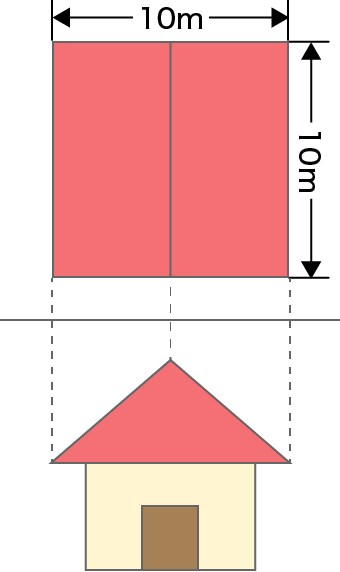Drainage Capacities
Drainage Capacities
| Type of rain chain | MaxDrainage: Liter/hour. *1 |
|---|---|
| Toh | 720 |
| Toh-L | 2,500 |
| Ta-ke | 720 |
| Tama | 720 |
| Tama-L | 2,500 |
| Migumo | 720 |
| Migumo L | 2,500 |
| Ajiro | 720 |
| Hamon |
720 |
- *1 This figure indicates the maximum amount of water (liter/hour.) that a particular rain chain is able to drain. It will disperse some but the water will be drained.
- One gallon is approximately 3.8 liters.
Helpful Tips
For Hamon, the transmission of rainwater and its dispersal to the surrounding area is more affected by wind and water volume than in the case of other rain chains.
Therefore, when installing Hamon, it is recommended that it be installed in a location where rainwater splashing onto the surrounding area is not an issue.
When a rain chain is used where there are trees nearby, leaves can accumulate and clog the pipes, especially at the connection to the eave gutter.
Good water flow can be maintained by installing a leaf protection system at the connection to the eave gutter and by periodic cleaning.
Especially for silver rain chains, the surface may darken due to airborne dirt and dust on the surface.
If the surface darkens, it can be kept clean by wiping the surface with a wet cloth.
How to calculate rainfall and drainage capacity
We clearly indicate the drainage capacity of all our rain chains. It can be calculated as follows:
About precipitation
There is a unit of mm/hour for precipitation, which represents the amount of rain that falls per hour.
If 10 mm/hr of rain falls without any drainage or evaporation at all, this means that 10 mm of rain will be stored at the point of rainfall at a height of 10 mm.
Suppose rainfall of 10 mm/hr accumulates to 1m2 per hour.
10mm ✕ 1,000mm ✕ 1,000mm = 10,000,000 mm3
To convert mm3 to liters
1,000mm3=1 cm3
10,000,000 mm3 ÷ 1,000 mm3 = 10,000 cm3
1 cm3 = 1cc
1,000cc = 1 liter
10,000 cm3 ÷ 1,000cc = 10 liter
The calculation results in 10 liter.
- This Resource is given in millimeters. Please calculate and change the units as necessary.
- One inch is 25.4mm or 2.54cm.
Relationship between roof and precipitation
The larger the roof area, the greater the overall rainfall collected.
The area of a roof viewed vertically is called the projected roof area. Multiplying the projected roof area (m2) by the amount of rain that accumulates per m2 calculated from the amount of precipitation (mm/hr), will give you the amount of rainwater that falls on the roof.
For example, a roof with a length and width of 10m square is 100 m2, but if 10 mm/hr of rain falls on that roof, it can be calculated that 10 liters of rainwater will be stored in 1 m2, so in an area of 100 m2 :
100 m2 ✕ 10 liter = 1,000 liter
The calculation results in 1,000 liters of rain per hour on the roof.

Figure: Projected Roof Area
Drainage capacity of rain chains
The drainage capacity of individual rain chain is expressed in liters/hour. Regarding the amount of water that can be drained per hour, after calculating the amount of rain that falls on the roof area, the amount of water per rain chain should not exceed the drainage capacity of the rain chain.
Our chain gutters and tubes can handle 720 liters of rainwater per hour, but if the above calculation results in the treatment of 1,000 liters of rain then:
1000 liters ÷ 720 liters = 1.3888・・・・・
Therefore, it can be calculated that one rain chain is not enough and two are needed.
Other
If the roof area is large and the rain chain does not have sufficient drainage capacity, it is necessary to use a typical vertical downspout, or to create a system to prevent rainwater from overflowing the rain chain. When using ordinary downspouts (pipe-type downspouts) in combination, water splashing can be reduced by using a larger size downspout and ensuring that the downspout has the capacity to drain the entire area without problems during heavy rainfall, and then narrowing the drainage opening diameter in the rain chain so that water does not exceed the drainage volume when flowing into the rain chain
Alternatively, if you have areas where rainwater can be dumped in an emergency situation, a gargoyle-like mechanism can be created at the edge of the eave gutter to allow water to drop and escape.
Drainage Capacity Auto-calculation Form
Please use the following form to enter the amount of precipitation, roof area, and your selected rainwater chain. The form will calculate the number of products required for your condition.
For precipitation-[mm/hr] and roof area-[m] × -[m], the approximate number of rain chain is-.










